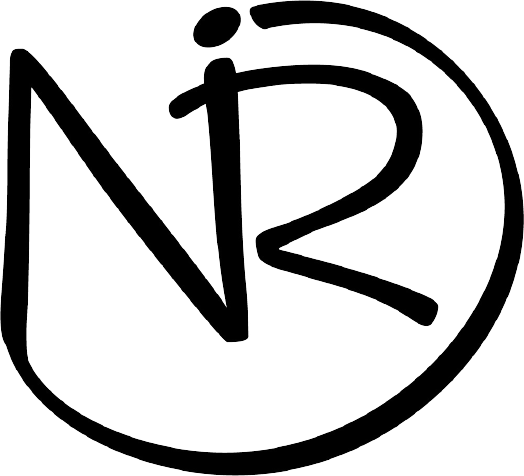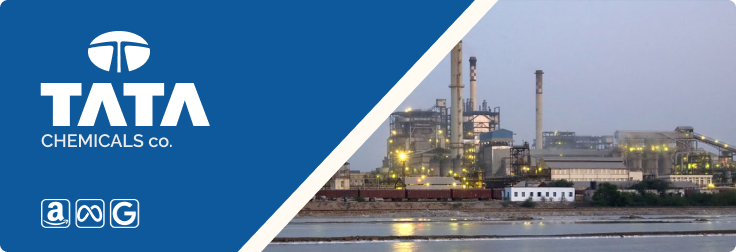
OVERVIEW
Tata Chemicals, a leading global chemicals company, launched a new product an artificial sweetener.
The company believed that the new sweetener has the potential to revolutionize the food and beverage industry. The sweetener was a natural, less-calorie. Hence, a better alternative to sugar or existing industrial sweeteners.
CHALLENGES FACED
Launching a new product in a crowded market is a daunting task, but it’s not impossible. In fact, it can be a great opportunity to differentiate your product and stand out from the competition.

3 MAJOR CHALLENGES
Launching a new product in a crowded market is always a challenge.
Launching a new product in a crowded market is a daunting task. There are already many established brands and products competing for the attention of potential customers.

The product was not designed for the consumer market, but rather for businesses.
B2B buyers are more complex and have different needs than B2C buyers.
They are more interested in the features and benefits of a product, rather than the emotional appeal. They also make decisions more slowly and carefully.

The online marketing of such a product requires a creative and strategic approach.
Online marketing is a powerful tool for B2B marketers. In order to be successful, we used a creative and strategic – hybrid approach that will cut through the noise and reach the target audience.
APPROACH
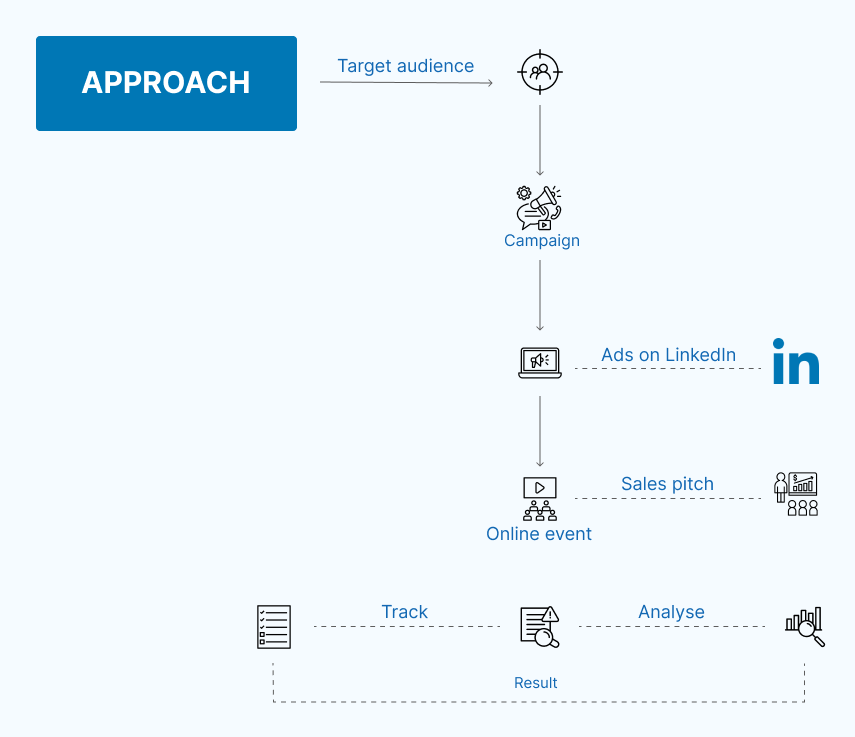
My team and I decided to take on online marketing for the product.
We were committed to providing a full-service marketing solution, from creating and managing advertising campaigns to organizing and executing online events.
After extensive market research and analysis, we created a foolproof strategy and launched the product in the market.
Our marketing plan included a targeted advertising campaign, a strong sales pitch, and a variety of other tactics to reach our target audience and generate interest in the product. We also developed a detailed timeline and budget for the launch, and we were committed to tracking and measuring the results of our marketing efforts.
WHAT DID WE DO?
I was the head of the marketing team. I worked closely with my entire team to ensure that our marketing strategies were aligned with the product roadmap and that we were effectively communicating the value of our product to our target audience.
We broke down the process into 3 distinct phases to ensure a smooth and efficient workflow.
PHASE 1 (3 WEEKS)

Me and my team decided to launch a brand awareness campaign on LinkedIn. We chose LinkedIn to run our ads because it is the best platform for reaching decision-makers in businesses.
With over 830 million members, LinkedIn is home to a vast network of professionals who are actively engaged in their careers. This makes it the perfect place to reach our target audience with relevant and timely advertising.
We were targeting people with the following criteria: KPI: Reach and CPM

Job Title
We targeted people with these 3 major positions in food industry
- CEOs
- VP of Sales
- VP of Marketing
For three weeks, we ran ads that introduced our products and services to this audience.

KPIs of Phase 1
We targeted people with these 2 KPIs:
- Reach
- Impressions
PHASE 2 (3 MONTHS)
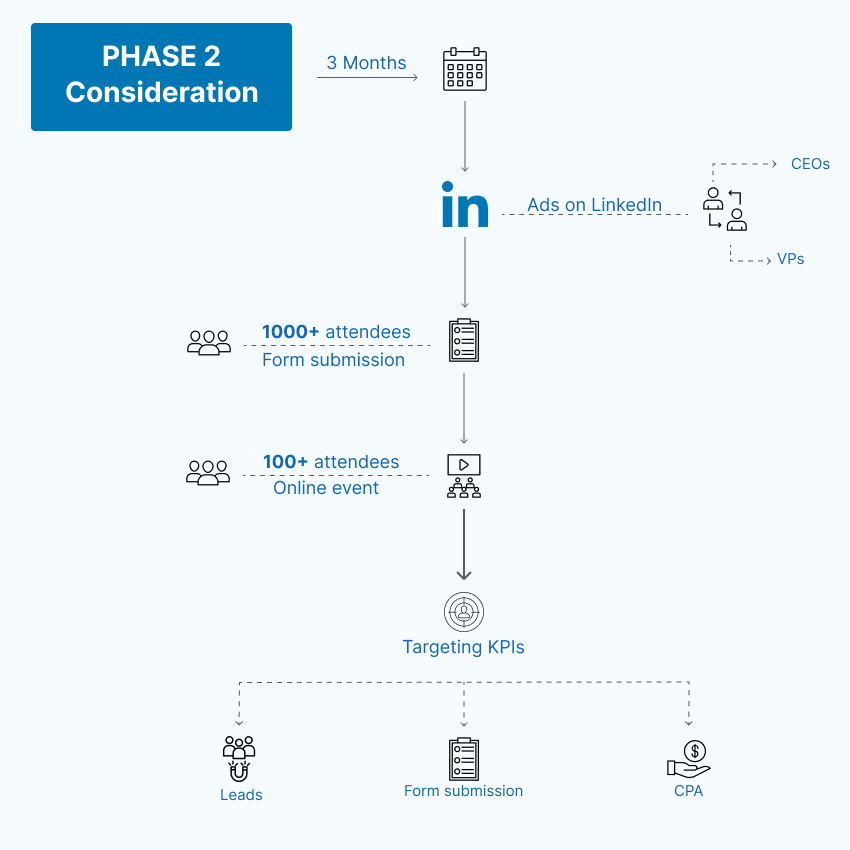
After evaluating the results of the initial campaign, we determined that up to 3 months of advertising run on the same platform would be the most effective way to reach our target audience and achieve our marketing goals.
The ads were run just a few months before the online event. This was all part of our strategy to establish a connection with our target audience through advertising even before the event.
Following months of running targeted ads, we organized a series of informative and interactive online events for our clients, the CEOs and VPs of food and beverage companies. The events were well-received, with over 100 executives attending.

KPIs of Phase 2
We targeted people with these 3 KPIs
- Lead
The number of people who showed interest after attending the online event. - CPA – Cost per acquisition/form submission
Cost per lead - Form submission
The number of people who showed interest in attending the online event.
TRACKING OF PHASE 1 AND PHASE 2
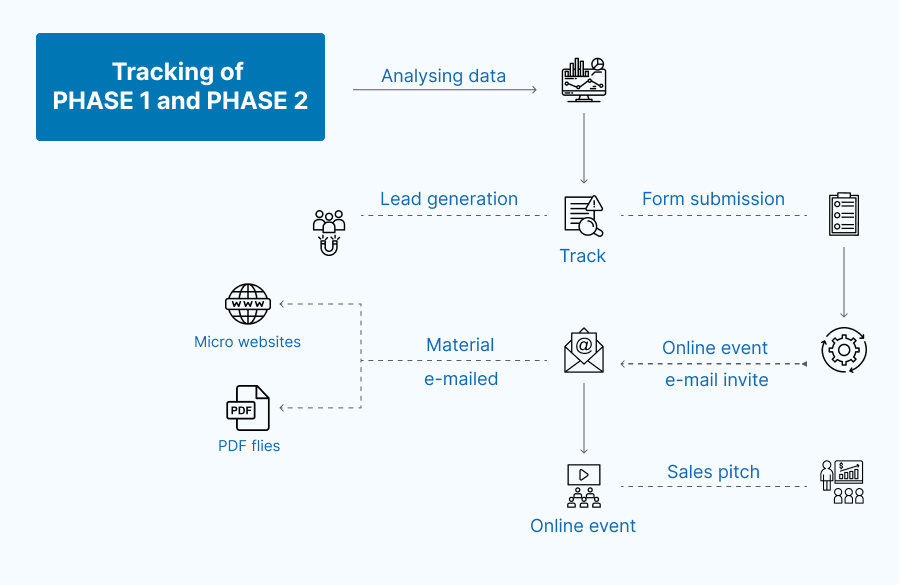
We closely monitored the leads and forms that were submitted. We also automated an email invitation to be sent to anyone who has filled out the form. This email would invite them to an online event, provide details about the event, and outline the topics that will be discussed. In the end, we also shared PDFs and micro-websites with our leads.
We tracked the acceptance rate of our meeting invitations to get an approximate idea of the number of attendees at the event.
By tracking the acceptance rate of our invitations, we were able to ensure that we were well-prepared for the event and that we could deliver a successful presentation.
PHASE 3

At the event, we delivered our product pitch, which included a detailed overview of the product’s features and benefits. We also highlighted the product’s unique selling points and how it could solve our target audience’s problems.

KPIs of Phase 3
We targeted people with these 3 KPIs:
- ROI
- CPC
- Conversion rate
RESULT

Over the past three months, we held bi-weekly online events, each of which attracted over 100 attendees. This resulted in a total attendance of over 600 people. We successfully converted 10% of these attendees into deals, which is equivalent to over 60 closed sales.
MY PART
Being the head of a marketing team, my duties were:

Strategist

Created a LinkedIn media plan for awareness and lead generation.
Prediction of the strategy outcomes with respect to the timeline.

Designed the strategies as per the stakeholder requirement and targeted audiences.

Make sure to deliver the deliverables and meet KPIs within the timeline.

Performance optimization across the different parts of strategy like creatives, content, UI/UX, ad account hierarchy, etc.

Drive the team in the same direction with the strategy we have created. Starting from branding to legal so that everyone is in sync.

Operation Lead

Leading the operation team and setting the KPIs metrics to records for optimization.

Designed ad account skeleton and set nomenclature rules.

Troubleshooting if any team member faces any trouble like ad getting disapproved.

Led the automated process like bidding, data filtering, and conversion tracking.

Set budget limits across the platforms.

Analytics and data engineering

Managed the analyst and data engineering team.

Choose the data visualization tool and data warehouse and model.

Created UI/UX of the dashboards as per strategies and stakeholders.

Selected the API connections across the platforms for a smooth flow of data.

Setting up the documentation structure.

Growth Consultant / Performance Marketer

Made important interconnected decisions across the strategy, operation, analyst, and data engineer teams. Like choosing and finalizing the best landing page, creative, content, etc.

Read daily, weekly, and monthly analytics for optimizing strategy which includes improving creatives, content, UI/UX, and biddings.

Set A/B testing and optimizing conversion rate.

Made sure of the implementation of the latest performance marketing trends and technologies.

Fixed high CPA and CPM depending on the phase.

Presented the project’s updates to stakeholders and POC.

Tools I used for the above tasks

Advertising Platforms
LinkedIn ads

Business Indulgence Tools
Tableau
Google Looker Studio

Data Warehouse and API
Google BigQuery
SuperMetric

Designing Tools
Adobe Photoshop
Adobe Illustrator
Figma

Email automation
Brevo
